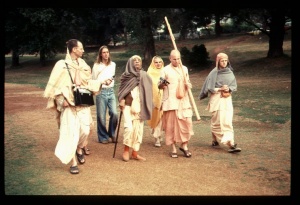CC Madhya 20.347 (1975): Difference between revisions
(Vanibot #0027: CCMirror - Mirror CC's 1996 edition to form a basis for 1975) |
(Vanibot #0020: VersionCompareLinker - added a link to the Version Compare feature) |
||
| Line 2: | Line 2: | ||
<div style="float:left">'''[[Sri Caitanya-caritamrta (1975)|Śrī Caitanya-caritāmṛta (1975)]] - [[CC Madhya (1975)|Madhya-līlā]] - [[CC Madhya 20 (1975)|Chapter 20: Lord Śrī Caitanya Mahāprabhu Instructs Sanātana Gosvāmī in the Science of the Absolute Truth]]'''</div> | <div style="float:left">'''[[Sri Caitanya-caritamrta (1975)|Śrī Caitanya-caritāmṛta (1975)]] - [[CC Madhya (1975)|Madhya-līlā]] - [[CC Madhya 20 (1975)|Chapter 20: Lord Śrī Caitanya Mahāprabhu Instructs Sanātana Gosvāmī in the Science of the Absolute Truth]]'''</div> | ||
<div style="float:right">[[File:Go-previous.png|link=CC Madhya 20.346 (1975)|Madhya-līlā 20.346]] '''[[CC Madhya 20.346 (1975)|Madhya-līlā 20.346]] - [[CC Madhya 20.348 (1975)|Madhya-līlā 20.348]]''' [[File:Go-next.png|link=CC Madhya 20.348 (1975)|Madhya-līlā 20.348]]</div> | <div style="float:right">[[File:Go-previous.png|link=CC Madhya 20.346 (1975)|Madhya-līlā 20.346]] '''[[CC Madhya 20.346 (1975)|Madhya-līlā 20.346]] - [[CC Madhya 20.348 (1975)|Madhya-līlā 20.348]]''' [[File:Go-next.png|link=CC Madhya 20.348 (1975)|Madhya-līlā 20.348]]</div> | ||
{{CompareVersions|CC|Madhya 20.347|CC 1975|CC 1996}} | |||
{{RandomImage}} | {{RandomImage}} | ||
==== TEXT 347 ==== | ==== TEXT 347 ==== | ||
| Line 13: | Line 12: | ||
:guṇa-jñāḥ sāra-bhāginaḥ | :guṇa-jñāḥ sāra-bhāginaḥ | ||
:yatra saṅkīrtanenaiva | :yatra saṅkīrtanenaiva | ||
:sarva-svārtho | :sarva-svārtho 'bhilabhyate | ||
</div> | </div> | ||
| Line 20: | Line 19: | ||
<div class="synonyms"> | <div class="synonyms"> | ||
kalim—the Kali-yuga; sabhājayanti—worship; āryāḥ—advanced people; guṇa-jñāḥ—appreciating this good quality of Kali-yuga; sāra-bhāginaḥ—persons who accept the essence of life; yatra—in which age; saṅkīrtanena—simply by performing saṅkīrtana-yajña, the chanting of the Hare Kṛṣṇa mantra; eva—certainly; sarva-sva-arthaḥ—all interests of life; abhilabhyate—are achieved. | |||
</div> | </div> | ||
| Line 27: | Line 26: | ||
<div class="translation"> | <div class="translation"> | ||
" 'Those who are advanced and highly qualified and are interested in the essence of life, know the good qualities of Kali-yuga. Such people worship the Age of Kali because in this age, simply by chanting the Hare Kṛṣṇa mahāmantra, one can advance in spiritual knowledge and attain life's goal.' | |||
</div> | </div> | ||
| Line 34: | Line 33: | ||
<div class="purport"> | <div class="purport"> | ||
This is a quotation from Śrīmad-Bhāgavatam ([[SB 11.5.36]]) spoken by the great sage Karabhājana Ṛṣi, one of the nine Yogendras. The sage was informing Mahārāja Nimi about the | This is a quotation from Śrīmad-Bhāgavatam ([[SB 11.5.36|11.5.36]]) spoken by the great sage Karabhājana Ṛṣi, one of the nine Yogendras. The sage was informing Mahārāja Nimi about the people's duty to worship the Supreme Personality of Godhead according to different processes in different yugas. | ||
</div> | </div> | ||
Latest revision as of 13:20, 27 January 2020

A.C. Bhaktivedanta Swami Prabhupada
TEXT 347
- kaliṁ sabhājayanty āryā
- guṇa-jñāḥ sāra-bhāginaḥ
- yatra saṅkīrtanenaiva
- sarva-svārtho 'bhilabhyate
SYNONYMS
kalim—the Kali-yuga; sabhājayanti—worship; āryāḥ—advanced people; guṇa-jñāḥ—appreciating this good quality of Kali-yuga; sāra-bhāginaḥ—persons who accept the essence of life; yatra—in which age; saṅkīrtanena—simply by performing saṅkīrtana-yajña, the chanting of the Hare Kṛṣṇa mantra; eva—certainly; sarva-sva-arthaḥ—all interests of life; abhilabhyate—are achieved.
TRANSLATION
" 'Those who are advanced and highly qualified and are interested in the essence of life, know the good qualities of Kali-yuga. Such people worship the Age of Kali because in this age, simply by chanting the Hare Kṛṣṇa mahāmantra, one can advance in spiritual knowledge and attain life's goal.'
PURPORT
This is a quotation from Śrīmad-Bhāgavatam (11.5.36) spoken by the great sage Karabhājana Ṛṣi, one of the nine Yogendras. The sage was informing Mahārāja Nimi about the people's duty to worship the Supreme Personality of Godhead according to different processes in different yugas.